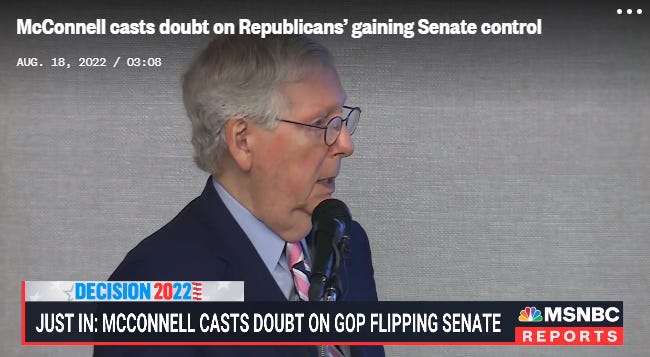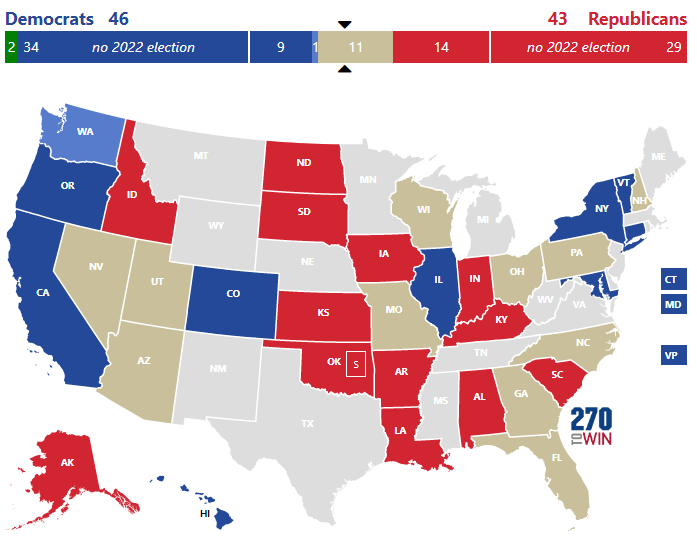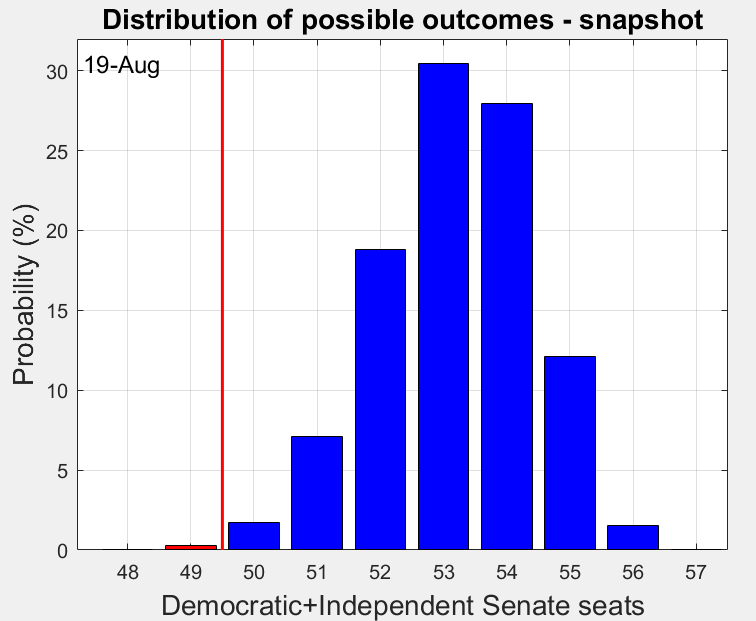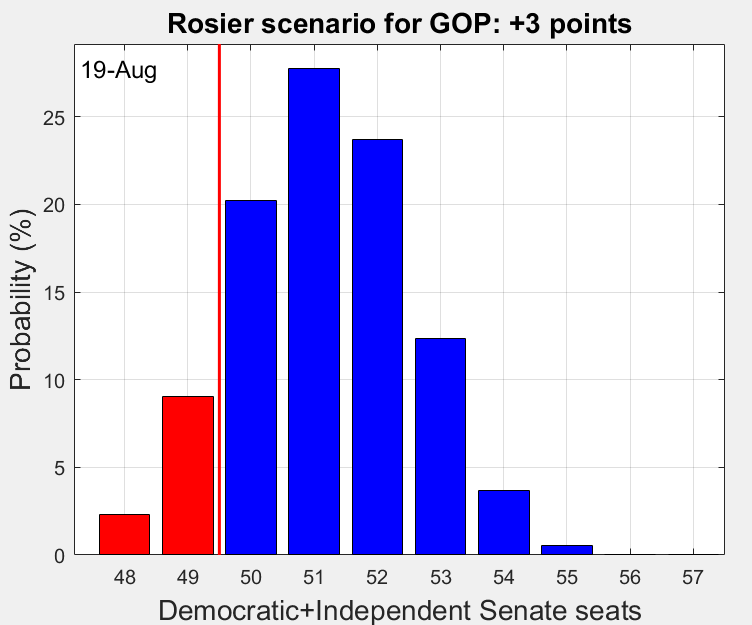Will an antiquated voting rule cost Republicans the Senate?
Rewarding extremism in the primary, losing the general - and several seats.
Republican Senate leader Mitch McConnell sees the writing on the wall. He thinks the weakness of his party’s Senate nominees may doom his chances of becoming Majority Leader once again. The data support his view.
However, there’s a reform that could have avoided this situation - and can potentially help pull the nation back from the brink of democracy’s breakdown.
Usually it’s Republicans who are suspicious of innovations in voting rules such as ranked-choice voting. But if they fail to retake control of the Senate this year, it will be in part due to antiquated rules that prevent the majority from getting a candidate of its choice.
As recently as spring, analysts thought Democrats would have a tough time holding onto the Senate. After all, the Senate is divided 50-50, and the national environment in a midterm election usually goes against the President’s party. But that environment has shifted. The D-vs.-R margin in generic Congressional preference ballot, which is becoming an increasingly good predictor of the November outcome, has moved three points toward Democrats since May. And Senate polling has moved in the same direction.
By almost any count, Democrats start with 46 safe seats:
Add two states where Democrats currently have leads greater than ten points (Arizona D+12% and Pennsylvania D+14%) and Utah (R+14%) and that makes 48 safe seats for . Democrats, 44 seats for Republicans, leaving 8 states of uncertain outcome.
At this point, one can set a fairly wide range of outcomes. Polling errors in midterm elections can be large in either direction. In 2020, errors in Senate races were worse than errors in the Presidential race, when the average difference in the two-candidate margin between final polls and actual outcome was seven points. These discrepancies are even larger than the expected amount of change in polls between now and Election Day. So we can use current August polls to identify the “knife-edge” swing races (7 points or closer).
There are 8 such knife-edge races, from D-leaning to R-leaning: Ohio, New Hampshire, Nevada, Georgia, Wisconsin, North Carolina, Florida, and Missouri. I looked at the Princeton Election Consortium standard of most-recent 3 polls or last 3 weeks, whichever gives more surveys. Currently, Democrats lead in 6 of the 8 swing races: Wisconsin (D+4%), New Hampshire (D+4%), Ohio (D+3%), Nevada (D+3%), Georgia (D+3%), and North Carolina (D+2%). And Val Demings (D) is tied with Senator Marco Rubio (R) in Florida. That sets the likely range of outcomes as 48 to 55 Democratic seats.
You can see why Senator McConnell is pessimistic. His party would have to run the table, losing no more than one of these states. Yet things are quite different: even in places where Republicans were thought to be safe, such as Florida and Wisconsin, there are clear problems.
This isn’t just a case of the national temperature changing after a series of major news events (the repeal of Roe v. Wade foremost - but also see falling gas prices, the passage of the Inflation Reduction Act and historic climate change legislation, and the FBI search of Trump’s resort).
There is also the matter of candidate quality. Republicans have nominated some controversial candidates, to say the least. Down the line, they are endorsed by former President Trump: J.D. Vance (Ohio), Adam Laxalt (Nevada), Herschel Walker (Georgia), Ron Johnson (Wisconsin) and Ted Budd (North Carolina). Add to this Blake Masters (Arizona) and Mehmet Oz (Pennsylvania), who nobody is really expecting to pull their campaigns out of the fire.
To win their primary elections, these Republican candidates had to endorse the lie that the 2020 election was stolen, whether they believed it or not. They ran in a conventional process (“first past the post”) in which they needed to win a plurality of Republican voters. And Donald Trump commands the loyalty of not just a plurality, but a sizable majority of such voters.
Under traditional notions of partisan politics, the primary is supposed to nominate the candidate who is considered to have the strongest chance at winning the general election. Contrast this with Arizona, Jim Lamon and Mark Brnovich performed 1.6-2.3 points more strongly against Mark Kelly than Blake Masters did (average of four surveys). Candidates with potential crossover appeal such as Jane Timken and Matt Dolan in Ohio were likewise left behind by Republican voters, sometimes by wide margins. And other moderate candidates didn’t even run. After all, why bother when the rules work against you?
We’ll never know how these candidates would perform in the give-and-take of a general election campaign. But considering that Democratic polling leads in 6 Senate races are smaller than 5 points, such small differences might make a difference in the home stretch.
To illustrate this, see what happens if we shift current polls just 3 points. First, here is the distribution of outcomes based on today’s polls (again, median of last 3 polls or 3 weeks).
Based on these numbers, in an election based on today’s apparent conditions, Democrats would be likely to get between 51 and 55 seats.
However, with better candidates, a shift of three points toward Republicans leads to a different picture:
In this rosier scenario, Democrats would be likely to end up with between 49 and 53 seats - putting control within reach for Republicans.
On top of this, consider that in 2024, 23 Democratic/independent seats are up for election and only 10 Republican seats. Even if Republicans do not win the majority this time, they would have an excellent shot at doing so just two years later. (They still might.)
Could Republicans have avoided the outcome feared by McConnell? Yes! If they used ranked-choice voting in a general election context, they would have ended up with stronger candidates, and potentially more win. Here is how.
One such reform, called “Final Four,” is currently in use in Alaska. The first stage took place Tuesday, in an all-party primary whose top four vote-getters advance to the general election. Those four candidates - incumbent Lisa Murkowski (R), Kelly Tshibaka (R), Patricia Chesbro (D), and probably Buzz Kelley (R) - will participate in a ranked-choice election in November. Such a mechanism allows Democrats to weigh in on Republicans, and vice versa, giving an advantage to the more moderate candidate. For this reason, moderate Republican Lisa Murkowski, who won 44% of the vote, is expected to have an excellent chance against Trumpist Republican Kelly Tshibaka, who won 40% of the vote. Murkowski should be preferred over Tshibaka by Democrats in the November ranked-choice election, thereby holding onto her seat. In this way, ranked-choice voting in the Alaska Senate election will likely fulfill its promise to favor the more moderate candidate.
(It is important to note that a moderation-favored outcome is not guaranteed. Also in Alaska on Tuesday, there was a ranked-choice election Tuesday to fill Alaska’s vacant at-large House seat. Democrat Mary Peltola has 38% of first-choice votes, Trump-endorsed Republican Sarah Palin has 32%, and more moderate Republican Nick Begich has 29%. If third-place Begich is eliminated and enough of his votes are reassigned to Palin, she will go to Congress. But that’s only n=1, as they say. How often would such a contrary outcome occur? It’s possible to use math to estimate future scenarios, and I’ll write more about that after the outcome is settled.)
Back to the Senate. Some of you may think that Democrats retaining control of the Senate is a good thing, and therefore it’s great that Republicans are putting up hard-to-elect nominees. However, is it really great for you or your party if your electoral success depends on the other side nominating extremists? Some extremists, somewhere, will win in November - maybe a lot of them. Many of them are running in swing states where it is essential to administer elections honestly. (Wisconsin, currently D+3% for Governor Evers, comes to mind.) More generally, to state the obvious, having fewer politicians who deny basic mechanisms of democracy is a good thing. (For a scientific look at this topic, see my recent PNAS article on polarization and instability in politics.)
This fall, Final Four voting is on the ballot as a citizen initiative in Nevada. That’s one of the 8 swing states. If Republicans fail to retake the majority in November, their leaders may want to support this reform in other states as well. Modernizing the voting rules can favor candidates with crossover appeal. Applied at the state and local level, it could save them - and the nation - from some of the worst excesses of partisan extremism.








A question on ranked choice voting:
Surely you have thought about using a condorcet method.
(Condorcet = if any candidate would will all 1 on 1's, that candidate must win)
During last year's NYC mayor's race the three strongest candidate were Adams, Garcia and Wiley.
It looked quite possible to me that Garcia would be eliminated in the penultimate round and hand final victory to Adams even though Garcia could be the condorcet choice.
See https://en.wikipedia.org/wiki/2021_New_York_City_mayoral_election#Results_by_round
So, it is far from a theoretical concern.
Would the public have trouble understanding?
Would it be too hard to do the IT work?
Surely the whole idea of ranked choice is to produce a condorcet winner ...
P.S. If Garcia had been knocked out by Wiley, and Adams went on to win, we would have been drowned in editorials using the word "condorcet" - maybe such an event is what is needed?
Thanks for the excellent analysis.